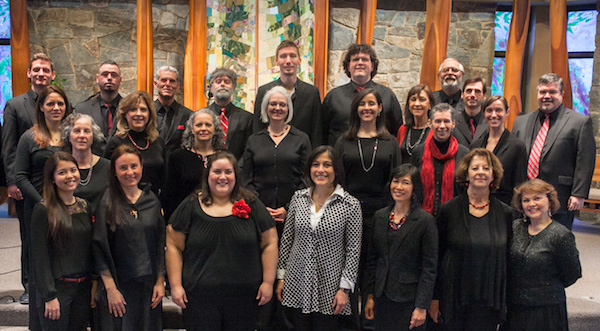After 25 years at the podium, Diana Sáez, founder and artistic director of Coral Cantigas, will direct the group’s final notes on the evening of Saturday, June 4, at River Road Unitarian Universalist Congregation in Bethesda. Coral Cantigas has been the only choral group across the world that performs exclusively Latin American, Spanish and Caribbean repertoires.
The group’s final show in the U.S. is both a farewell and a commemoration of its 25th anniversary. For the occasion, Sáez commissioned a special piece: a composition for mixed choir and classical guitar by Chilean composer Javier Farías, “La Sangre Derramada” (Spilled Blood). Coral Cantigas will officially disband after performing in Cuba at the end of June.
Sáez, who holds a doctorate in musical arts in choral conducting, has been widely acclaimed for her creative programming “entrelaza,” an interweaving of a variety of cultural themes, styles and languages. As director of the World Bank/International Monetary Fund Chorus, assistant conductor of University of Maryland Women’s Chorus and music director of the Women’s Choir of the Catholic University of America, she has been at the forefront of the development and integration of choral music worldwide.

In an interview with CultureSpotMC.com, Sáez tells of the joy and challenges of running Coral Cantigas, and why it’s time for her to move on.
Why are you disbanding now?
I’d like to think we’ve made our mark. In choral music I see that the trend has changed for the better, and I see more and more choirs performing whole concerts of Latin American music. More and more, I see the connections between the music we’ve been performing and the music from other parts of the world.
Was reaching that niche audience in this area challenging?
It is a challenge for every Latino cultural organization–how to reach the Latino audience, because there is no such thing as just one Latino audience. There is not one thing that can summarize the Latin American culture. We can perform a piece from a Venezuelan composer, but not all Venezuelans will care. Plus, this is a very transient community, people come to work for the World Bank, the IDB, etc., and they leave. (Choral music) is so universal, and our programming is not. We’ve had to market to a very diverse audience; half of that audience is not Latino.
How did you manage to always fill the house?
I had to learn how to play politics. When I think of programming, I am not thinking of Latino audiences, nor support from Latin American organizations. For example, the embassies–you would think they would be very supportive, but that’s not necessarily true. The beauty of choral music is that it’s all about the text. There’s something about the music that is intrinsic to it, no matter the language. The audience comes for the sounds, the diversity, and the poetry.
What other challenges did you face?
Fundraising and marketing were challenging. The marketing strategies have changed so fast, but we’ve gone with the flow. I remember we were very scared when Facebook came out–privacy concerns, etc.–and now I cannot imagine doing things without social media. All of a sudden, marketing became more competitive: how to keep up with the information, the database, how to use that information and keep it updated.
What’s your most memorable concert?
In October of 2001, we had plans to go to Puerto Rico. We had just started rehearsals for the tour when 9/11 happened. I thought no one would show up to the next rehearsal after the event, but to my surprise, everyone showed up. That day, the rehearsal went as usual. Somehow that told me that we all needed to get together and remain the same. I remember we got together and said, “Do you think we should still go?” We all said “yes.”
We all breathed a sigh of relief when the plane landed in Puerto Rico. Then, while we were there, the war started in Afghanistan, and we panicked. Some of us felt very far from home.
But that night, we sang beautifully. Things like that make you realize how healing music can be; it was very special. We were very sensitive that day; our hearts were into that interpretation. Coincidentally, a song we chose acquired more meaning that day: “Entre el Espanto y la Ternura” (Between Horror and Tenderness).
What’s next for you?
I tend to think more universally now, and if I were to start another group, it would have a more universal focus. I would like to publish a little more, because while in Cantigas, I have made several arrangements of folk music. It’s a transitional but exciting time.
Any parting words?
June 4 is going to be a big celebration of our legacy. I’m very proud of our legacy. I’m very proud of what we’ve done, and I know that this repertoire will be appreciated and that people will expect more. Performing in front of several hundred people in the audience at the Millennium Stage and on stages around the world has been an honor for us.